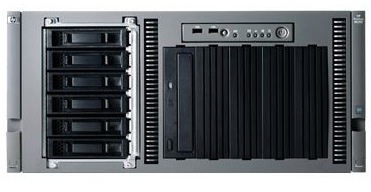 The hardware we will use is a HP Proliant ML350. It contains:
The hardware we will use is a HP Proliant ML350. It contains:
- 2 x QuadCore processor 2.50Ghz = 8CPU's
- E200i raidcontroller : 6 x 1TB disk
- 1 HP NetXtreme II network controller
- 32 GB memory
To allow virtualization features of the CPU to be used, we have to enable the VTx flag in the bios. This is off by default.
Disk Configuration
The chassis contains 6 disks, so we could have made a Raid5 from this disks, therefore getting the most of storage. Still we decided to split it up in 2 disks (in Mirror) + 4 disks (Raid5). The reason we did this has to do with grub and the incompatibility with a GPT table: to allow the OS to use a partition larger then 2 TB, we require the GPT label on a disk. Lilo can handle this, but GRUB as a bootloader can not (at least not out of the box). Lilo on the other hand is not compatible with XEN, which we can use for virtualization.
The results:
- 2 disks (HW Mirror) + grub as a bootloader (/boot (100MB), swap (16GB), / (100GB), /var (the rest)
- 4 disks (HW Raid5) + gpt as a partition table (/data full capacity)
When installing the OS we do not partition the /data partition but do it manually when everything is installed.
Distribution
Of course we have a lot of options here, SLES, Debian, Redhat. We found that most of the virtualization tools we wanted to use (cobbler, koan, spacewalk, puppet, func), we more standardly supported by the Redhat variant OS. So we decided on using Centos 5.2 x86_64 as our distribution.
Packages
When installing we choose to only install the base group + virtualization. This installs indeed the basis + everything required for Xen.
Because we selected this option, Centos default installs the kernel-xen and not the standard kernel. So we have to install this afterwards ( #yum -y install kernel). If you don't use the xen-kernel install but use the standard kernel, there are two files that need extra attention:
- /etc/sysconfig/kernel: specify the kernel that is the default. This defines after an upgrade what kernel will be updated and selected
- /boot/grub/grub.conf: select the kernel that you want to boot by default
We decided to enable selinux and firewalling because this will give as better understanding on which files and network connections are used.
Manual partition /data
As said before, /data is larger then 2TB. This requires the disk to be labeled as GPT. After this has been done, fdisk SHOULD NOT be used to change anything on the disk. Use parted instead.
This transcript will show the process:
- starting from an already partioned disk as standard partition using fdisk -> 2199GB
- using parted for 100% capacitity -> 800GB
- changed with mklabel to GPT -> 3TB
Model: Compaq Smart Array (cpqarray) Disk /dev/cciss/c0d1: 3001GB Sector size (logical/physical): 512B/512B Partition Table: msdos
Number Start End Size Type File system Flags 1 0.51kB 2199GB 2199GB primary ext3 boot
(parted) rm 1
(parted) mkpart primary File system type? [ext2]? ext3 Start? 0 End? 100% (parted) print
Model: Compaq Smart Array (cpqarray) Disk /dev/cciss/c0d1: 3001GB Sector size (logical/physical): 512B/512B Partition Table: msdos
Number Start End Size Type File system Flags 1 32.3kB 801GB 801GB primary
(parted) mklabel gpt Warning: The existing disk label on /dev/cciss/c0d1 will be destroyed and all data on this disk will be lost. Do you want to continue? Yes/No? Yes New disk label type? [msdos]? gpt (parted) print
Model: Compaq Smart Array (cpqarray) Disk /dev/cciss/c0d1: 3001GB Sector size (logical/physical): 512B/512B Partition Table: gpt
Number Start End Size File system Name Flags
(parted) mkpart Partition name? []? data File system type? [ext2]? ext3 Start? 0 End? 100% (parted) print
Model: Compaq Smart Array (cpqarray) Disk /dev/cciss/c0d1: 3001GB Sector size (logical/physical): 512B/512B Partition Table: gpt
Number Start End Size File system Name Flags 1 17.4kB 3001GB 3001GB data
(parted) quit Information: Don't forget to update /etc/fstab, if necessary.
[root@myserver ~]# fdisk -l /dev/cciss/c0d1
WARNING: GPT (GUID Partition Table) detected on '/dev/cciss/c0d1'! The util fdisk doesn't support GPT. Use GNU Parted.
Disk /dev/cciss/c0d1: 3000.5 GB, 3000513552384 bytes 255 heads, 63 sectors/track, 364791 cylinders Units = cylinders of 16065 * 512 = 8225280 bytes
Device Boot Start End Blocks Id System /dev/cciss/c0d1p1 1 267350 2147483647+ ee EFI GPT
#Now the disk is ready to be formatted
[root@myserver ~]# mkfs.ext3 /dev/cciss/c0d1p1
#gpt tables don't work with /LABEL in fstab, so you might need to specify the full path in there:
/dev/cciss/c0d1p1 /data ext3 defaults 1 2





